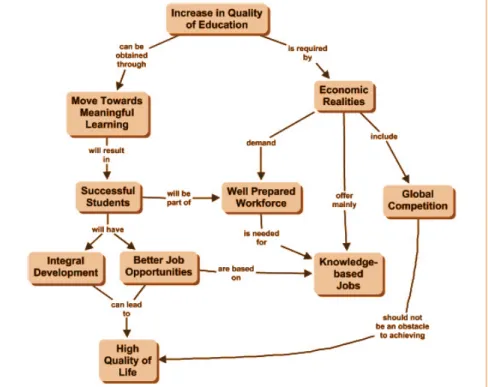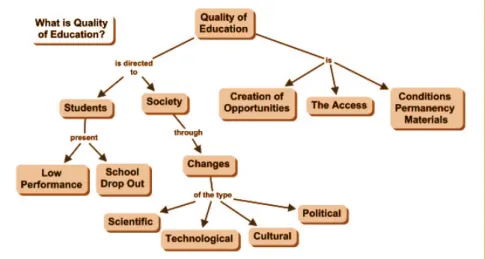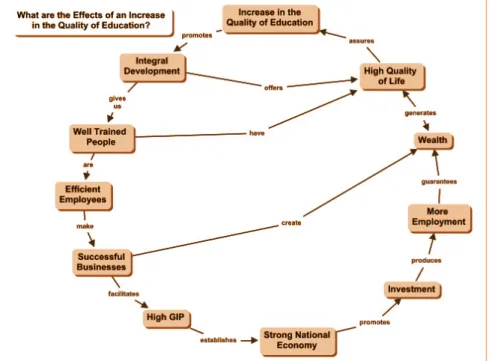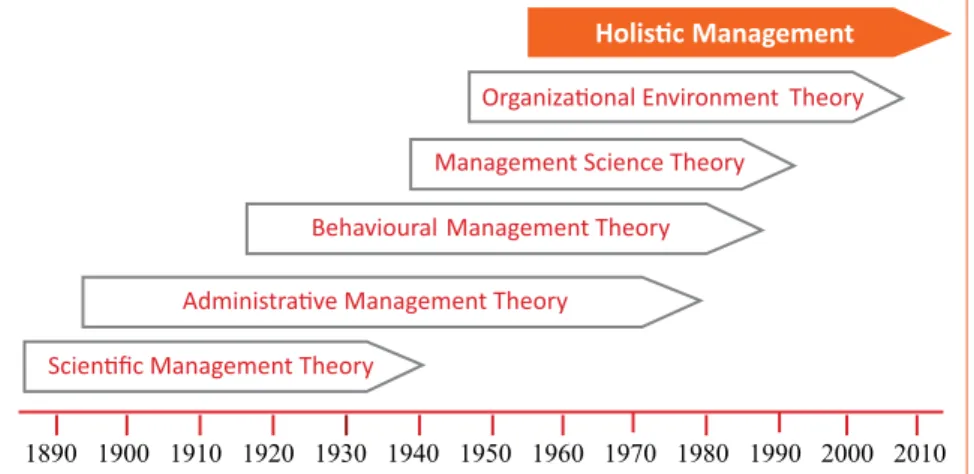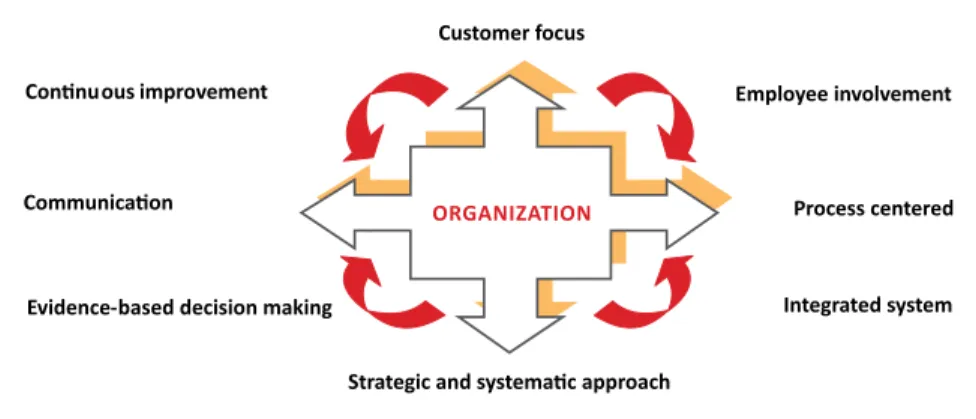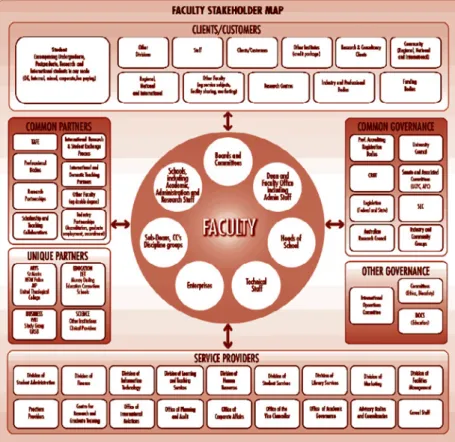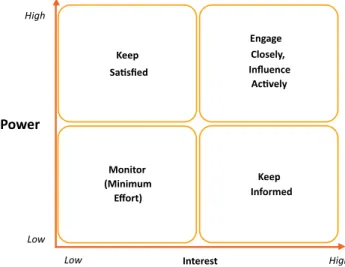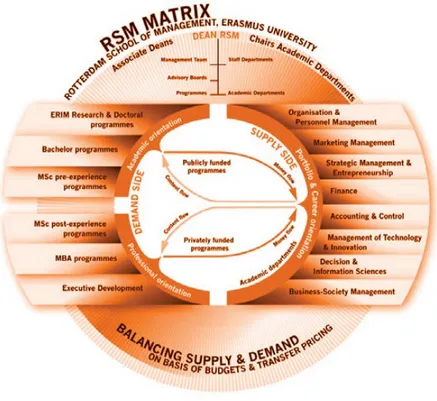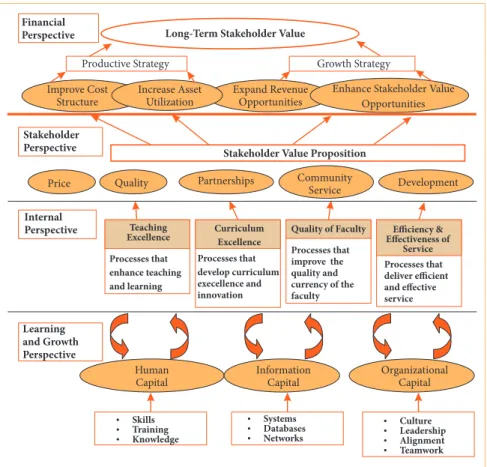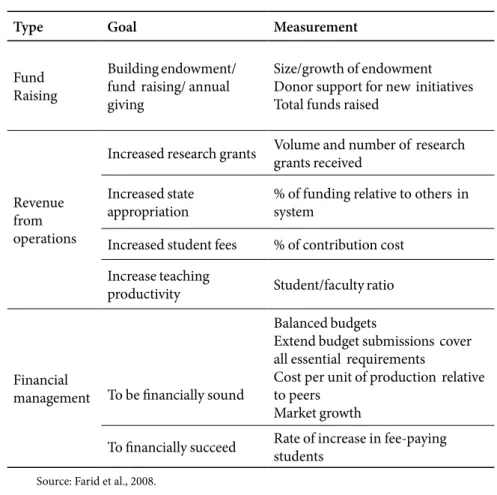The purpose of this book and, in parallel, the proposed course on Quality Management in Master’s degree programs is to develop understanding of CSR (Corporate Social Responsibility) integrated quality philosophies, quality management methods and tools, which are synthesised and applied in contemporary organisations to ensure high quality of socially responsible performance and excellence in products and services, particularly focusing on higher education institutions, i.e. universities.
The book provides additional practices with insights of modern views on quality as holistic management, responsibility and integrity tailored to classical approaches. It specifically addresses the CSR focused proactive engagement of primary higher education quality stakeholders (i.e. Master’s degree students) in the process of managing quality and performance excellence particularly at universities through participatory active learning methods: problem-based learning, discussion-based teaching, brainstorming, panel discussions, exploratory practical tasks based on critical analysis. Each topic is developed with continuous learning tasks, addressed to acquire demanded competencies for managing quality and performance excellence and develop skills for finding innovative CSR-based quality management solutions for particular quality programme development. In line with issuing a challenge for primary higher education stakeholders by proactive engagement in creative study programme quality improvement process, it gives an opportunity of examining responsibility for quality in higher education on their own both from theoretical and practical backgrounds.
HIGHER EDUCATION
AND SOCIAL RESPONSIBILITY:
QUALITY MANAGEMENT
PERSPECTIVES
Rita Vilkė
ISBN 978-9955-19-620-4 H IG H ER E D U C AT IO N A N D SO C IA L R ES PO N SIB IL IT Y: Q U A LIT Y M A N AG EM EN T PE R SP EC T IV ESwww.mruni.eu
Student Workbook
MYKOLO ROMERIO UNIVERSITETAS
Rita Vilkė
HIGHER EDUCATION AND
SOCIAL RESPONSIBILITY:
QUALITY MANAGEMENT
PERSPECTIVES
Student Workbook
Vilnius 2014Leidinys yra finansuojamas iš projekto ,,Magistrantūros studijų programų tarptautiškumo didi nimas“ (kodas Nr. VP1-2.2-ŠMM-07-K-02-073) lėšų.
Recenzavo:
Prof. habil. dr. Žaneta Simanavičienė, Kauno technologijos universitetas Doc. dr. Agota Giedrė Raišienė, Mykolo Romerio universitetas
Mykolo Romerio universiteto Politikos ir vadybos fakulteto Vadybos instituto 2013 m. gruo-džio 5 d. posėdyje (protokolo Nr. 1VI-12) pritarta leidybai.
Mykolo Romerio universiteto Politikos ir vadybos fakulteto Vadybos studijų krypties bakalauro studijų programos (Organizacijų vadyba) ir magistrantūros studijų programų (Programų ir projektų vadyba, Strateginis inovacijų valdymas, Veiklos auditas), Vadybos ir vers lo administravimo studijų krypties magistrantūros studijų programos (Strateginis orga ni zacijų valdymas), Žmonių išteklių vadybos krypties magistrantūros studijų programos (Lyderystė ir pokyčių valdymas) komiteto 2013 m. gruodžio 5 d. posėdyje (protokolo Nr. 10-114) pritarta leidybai.
Mykolo Romerio universiteto Politikos ir vadybos fakulteto tarybos 2013 m. gruodžio 17 d. posėdyje (protokolo Nr. 1PV-20) pritarta leidybai.
Mykolo Romerio universiteto mokslinių-mokomųjų leidinių aprobavimo leidybai komisijos 2014 m. sausio 10 d. posėdyje (protokolo Nr. 2L-5) pritarta leidybai.
Visos knygos leidybos teisės saugomos. Ši knyga arba kuri nors jos dalis negali būti dau gi nama, taisoma arba kitu būdu platinama be leidėjo sutikimo.
PREFACE
Recent cataclysms of the volatile world reveal the urgent need to recognise new management systems appropriate to solve ravages of the fading industrial era. classical quality tools have been used by a range of organisations for decades, but they have not been widely recognised from corporate social responsibility perspective yet.
The concept of corporate social responsibility (cSR) has evolved over time and now it is concerned to a wide range of organisations given the market character of the environment with its emphasis on globalisation and competition. Facing current challenges of sustainable development, global leaders start focussing on the redesign management systems for improvement, taking into account energy efficiency, supplier engagement, stakeholder satisfaction, waste reduction, etc. At the same time, in an increasingly networked and globalised world, classical quality challenges evolve in a new context, with strong focus on socially responsible and sustainable stakeholder value.
plenty of cSR issues in terms of applications and relevant practices lately refer to a wide range of tactical level tools and approaches that can benefit greatly from quality framework. best practices worldwide demonstrate numbers of examples how world leaders develop stronger cases for action with robust holistic cSR integrated programmes for improvements in all sectors of activity. These attitudes tend to prompt the new holistic management paradigm for management improvement in the foreseeable future.
In this context, many educational institutions are trying to adopt a more business-like orientation to accomplish the changes. Higher education institutions are also implementing socially responsible practices in order to maintain competitive advantage through addressing economic, social and environmental issues with the primarily target of improved quality and performance excellence. cSR at universities – University Social Responsibility (USR) – is all about going beyond simply “what is required” in legislation, rules and regulations. Moreover, USR means to be transparent in the communication of its performance, to be well managed holding strong governance procedures, to be responsive to the needs of its stakeholders, responsible in its values, attitudes and actions, and able to be trusted. despite
the evolving debate concerning cSR and sustainability in higher education institutions and its direct link to quality assurance and quality enhancement, practical guidelines for cSR encouragement in universities through proactive involvement of primary higher education quality stakeholders remain unclear.
The purpose of this book and, in parallel, the proposed course on quality management is to develop understanding of cSR integrated quality philosophies, quality management methods and tools, which are synthesised and applied in contemporary organisations to ensure high quality of socially responsible performance and excellence in products and services, particularly focusing on higher education institutions, i.e. universities. The book provides additional practices with insights of modern views on quality as holistic management, responsibility and integrity tailored to classical approaches. In line with issuing a challenge for primary higher education stakeholders by proactive engagement in creative study programme quality improvement process, it gives an opportunity of examining responsibility for quality in higher education on their own both from theoretical and practical backgrounds.
The author appreciates the opportunity created by Mykolas Rome-ris University and the European Social Fund sponsored project “Interna-tionalization of master study programmes”, No Vp1-2.2-ŠMM-07-K-02-073 to deepen the knowledge and expertise in the field of master study process management excellence in leading European universities, particularly Rotterdam School of Management, Erasmus University, and other respective higher education institutions. The acquired expertise is reflected throughout the contents of this book. At the same time, the author gives appreciation to the respective experts and reviewers of the book for significant and valuable contributions made both for the quality of course content and course support material in terms of constructive remarks for improvement, and also colleagues. project team and administrative personnel is appreciated for contributions throughout the entire project implementation process and for their considerable support in reaching the final results.
TABLE OF CONTENTS
PREFACE ...3
INTRODUCTION ... 8
1. INTRODUCTION TO QUALITY: FOUNDATIONS OF QUALITY MANAGEMENT ... 10
Conspectus ... 10
Learning tasks ... 10
Support material ... 10
1.1. Defining concepts for complex phenomena ... 11
1.2. Views on quality concept in higher education ... 14
Further reading ... 18
Topic self-check tasks ... 19
2. EVOLUTION OF QUALITY MANAGEMENT: FROM PRODUCT QUALITY TO PERFORMANCE EXCELLENCE ... 21
Conspectus ... 21
Learning tasks ... 21
Support material ... 22
2.1. Debate under schools of management thought ... 22
2.2. Evolution of quality and the emerging stage in management thought ... 25
2.3. Shared concepts between quality and CSR ... 28
Further reading ... 30
Topic self-check tasks ... 30
3. CUSTOMER FOCUS: INTERNAL AND EXTERNAL QUALITY STAKEHOLDERS ... 32
Conspectus ... 32
Learning tasks ... 32
Support material ... 33
3.1. Identification of university stakeholders ... 33
3.2. Mapping stakeholders ... 35
3.3. Stakeholder analysis matrix ... 36
Further reading ... 40
Topic self-check tasks ... 40
4. WORKFORCE FOCUS: HUMAN RESOURCE MANAGEMENT FOR QUALITY AND PERFORMANCE EXCELLENCE... 42
Conspectus ... 42
Support material ... 43
4.1. Case study: HRM advanced practice at Rotterdam School of Management ... 43
4.2. Faculty HRM policies and instruments ... 44
Further reading ... 52
Topic self-check tasks ... 52
5. PROCESS FOCUS: UNDERSTANDING THE PROCESS APPROACH METHODOLOGY ... 54
Conspectus ... 54
Learning tasks ... 54
Support material ... 54
5.1. Case study: RSM Management Processes ... 55
5.2. Intellectual contributions ... 58
Further reading ... 60
Topic self-check tasks ... 61
6. MODERN TOOLS AND TECHNIQUES FOR QUALITY MANAGEMENT ... 62
Conspectus ... 62
Learning tasks ... 62
Support material ... 63
6.1. Excellence indicators in higher education ... 64
6.2. Balanced Scorecard for higher education institutions ... 67
6.3. Balanced Scorecard strategy map for study program ... 69
Further reading ... 75
Topic self-check tasks ... 76
7. DESIGN FOR QUALITY AND PERFORMANCE EXCELLENCE ... 78
Conspectus ... 78
Learning tasks ... 78
Support material ... 78
7.1. Innovative design in higher education: RSM case ... 79
7.2. University business model ... 80
Further reading ... 85
Topic self-check tasks ... 86
8. MEASURING AND CONTROLLING QUALITY ... 87
Conspectus ... 87
Learning tasks ... 87
Support Material ... 88
8.1. Quality assurance and control in higher education ... 88
8.3. Higher education quality costs ... 91
Further reading ... 93
Topic self-check tasks ... 94
9. CONTINUAL IMPROVEMENT ... 95
Conspectus ... 95
Learning tasks ... 95
Support material ... 95
9.1. Continual improvement in higher education... 96
9.2. Case study: continual improvement at HAMK University ... 97
Further reading ... 102
Topic self-check tasks ... 102
10. COURSE SUMMARY: PERFORMANCE EXCELLENCE IN THE TWENTY-FIRST CENTURY ORGANISATION ... 104
Conspectus ... 104
Learning tasks ... 104
Support material ... 104
10.1. Challenges of the changing globalised management environment ... 105
10.2. Holistic management systems: managing for quality and performance excellence in the twenty-first century ... 105
Further reading ... 108
Topic self-check tasks ... 109
BIBLIOGRAPHY ... 110
INTRODUCTION
This book provides methodological guidelines for the innovative seminars throughout the course of Quality Management in Master’s degree programs. It specifically addresses the cSR focused proactive engagement of primary higher education quality stakeholders (i.e. Master’s degree students) in the process of managing quality and performance excellence particularly at universities through participatory active learning methods: problem-based learning, discussion-problem-based teaching, brainstorming, panel discussions, exploratory practical tasks based on critical analysis.
The following topics are covered throughout the course, including lectures and seminars:
1. Introduction to quality: foundations of quality management; 2. Evolution of quality management: from product quality to
perfor-mance excellence;
3. customer focus: internal and external quality stakeholders;
4. Workforce focus: human resource management (HRM) for quality and performance excellence;
5. process focus: understanding the process approach methodology; 6. Modern tools and techniques for quality management;
7. design for quality and product/process excellence; 8. Measuring and controlling quality;
9. continuous improvement;
10. course summary: performance excellence in the twenty-first century organisation.
Each topic in these methodological guidelines is developed as follows: Conspectus – gives summary of core issues to be covered during the theoretical studies: lectures and individual readings (theoretical prerequisites for the topic).
Learning tasks – particular tasks focused to acquire required abilities and develop practical skills in managing quality and performance excellence in the twenty-first century organisations. Learning tasks are arranged continuously and implemented step-by-step in line with each topic, with the core final objective to develop a cSR-based (integrity: bottom-up approach) project (teamwork) for a particular study programme’s quality assessment and improvement:
Preparatory step A: brainstorming – quality concept map for a study programme;
Preparatory step B: literature analysis and synthesis, exploratory methods (practical tasks: collection and accumulation of scientific information, critical analysis, summary), critical analysis of quality and quality management understanding in different quality conceptions; critical analysis and evaluation of modern scientific quality management investigations and identification of classical quality conceptions;
Step 1: development of a study programme’s quality stakeholders’ analysis matrix;
Step 2: HRM principles and criteria for quality assurance of a study programme;
Step 3: development of a study programme process map;
Step 4: Self-assessment of study programme quality, formulation of quality vision and main targets for the study programme;
Step 5: Innovative design development for study programme;
Step 6: calculation of study programme quality costs;
Step 7: Identification of quality gaps in study programme process (map); development of proposals for continual improvement of the study programme.
Assessment to be performed during the last seminar - presentation of prepared innovative cSR-based quality management project for the study programme.
Support material – readings and cases arranged for problem-based learning with particular material to study and discuss (critical analysis) regarding the topic covered; implemented before (in line with) starting the learning tasks.
Further reading – theoretical prerequisites (required reading) and additional study material (recommended reading) for particular topic.
Self-check tasks – task for engaging in self-assessment.
Each topic is developed with continuous learning tasks, addressed to acquire demanded competencies for managing quality and performance excellence and develop skills for finding innovative cSR-based quality management solutions for particular quality programme development.
dEFINITIONS
Brainstorming– a group problem-solving technique that involves the spontaneous generation of ideas by all group members.
Concept mapsare graphical tools for organising and representing knowledge. They have two key components: “concepts” and “linking words” (also referred to as ‘linking phrases’). Linking words are used to join two or more concepts, thereby forming propositions (canas & Novak, 2009).
1. INTRODUCTION TO QUALITY: FOUNDATIONS
OF QUALITY MANAGEMENT
Conspectus
• Quality from management theories’ perspective • defining quality
• Judgmental perspective • product-based perspective • User- based perspective • Value- based perspective
• Manufacturing-based perspective • Integrating perspectives on quality • customer-driven quality
• Quality as a management framework
Learning tasks
1. Read the text on the approaches to the concept of quality of higher education.
2. Look through the given concept maps, compare and discuss the interconnectivity and dependency among major quality elements and results of increased quality of education in general.
3. brainstorm and develop a general quality concept map for higher education and specify a quality concept map for your study programme.
Support material
It is widely recognised by scholars and practitioners that both the concepts of quality and corporate social responsibility (cSR) are relatively confusing. Furthermore, defining quality with integrated cSR principals delivers a number of questions to be answered. practical experiences propose how general applicability of particular definition (e.g. quality) in different contexts usually further demonstrates its observed limitations to address measurable outcomes. And this does create much confusion in finding the appropriate tolls and techniques in quality management improvement decisions, moreover – in measurement. In fact, the reason is quite simple: quality and cSR means diverse things for different individuals, groups of individuals and organisations.
1.1. Defining concepts for complex phenomena
In a range of discourses, the concept of quality varies depending on the object and subject of research or the phenomena to investigate. According to cSR discourse in higher education, quality is one of those complex phenomena. parri (2006) states that “the guiding principle is that the more complex, many-folded or abstract the object under quality measurement is, the more difficult it is to come up with a satisfactory definition. The reason why it is not possible to find the one and only definition for higher education in literature lies in the fact that higher education is one of these objects” (p. 107).
Therefore, the very first step in managing for cSR integrated quality and performance excellence is to define the exact characteristics of the object to be improved perfectly properly. The best way to do this is to engage in this process those to whom the quality is addressed together with those by whom the quality and performance excellence is desired.
Methodologists worldwide provide a number of tools and techniques to define such complex concepts as quality and cSR. One of them is concept maps. canas and Novak (2009) define concept maps as “graphical tools for organizing and representing knowledge that explicitly express a person or group of persons’ understanding about a domain”. They state, that usually concept maps have two key components: “concepts” and “linking words” (also referred to as “linking phrases”). concepts are normally joined by linking words, which help in forming propositions. From their experience, researchers observe that object-type concepts usually lead to more descriptive
and often classificatory concept maps. With the aim to develop a more explanatory concept map, concepts might be replaced by events.
For instance, in order to find out the input for an outcome of “high quality of life”, we find a general input, namely “increase in quality of education” (see Figure 1.1).
Source: canas & Novak, 2009.
Fig. 1.1. Concept map on the increase in quality of education
In the proposed concept map (Figure 1.1), the concepts of “Increase in Quality of Education” and “Move Towards Meaningful Learning” are events interconnected with linking words, e.g. “can be obtained through”, “will result in”, etc. Indeed, it shows how increase in quality of education comes to integral development, which causes high quality of life as a desirable outcome of cSR.
canas and Novak (2009) propose the formulation of a focus question, which usually helps in delineating the simplified context for a particular
complex concept map; the focus question helps in clear specification of the problem or particular issue to resolve. continual research by canas et al. (2005) in concept maps reveals that its structures might indicate the level of thinking expressed in the map (see Figures 1.2 and 1.3).
Source: canas & Novak, 2009.
Fig. 1.2. Tree-structure quality of an education concept map generated from a static focus question
Tree-structure quality concept map (see Fig. 1.2) usually shows particular limitations for the formulation of the static focus question. The proposed example refers to the static focus question “What is Quality of Education?”. Therefore, it gives an opportunity at most to develop the structure of how the system is built up, but does not provide options for identifying interconnectivity between concepts and linking actions. Thus, it eventually causes difficulties in finding appropriate tolls and techniques in quality improvement decisions.
circular-structure concept maps (see Fig. 1.3) are usually developed from a dynamic focus question, e.g. “What are the Effects of an Increase in the Quality of Education?” and a root concept of “Increase in Quality of Education” (an event). Therefore, circular concept maps illustrate system-like approach towards quality and lead to significantly more instances of meaningful or dynamic managing for quality and performance excellence propositions.
Source: canas & Novak, 2009.
Fig. 1.3. Cyclic concept map generated from a dynamic focus question and a quantified root concept
The proposed concept maps illustrate a range of stakeholders concerned with quality issues in education as a whole. However, considering the fact that primary stakeholders for quality in higher education for performance excellence are students and academic community, it is reasonable to engage them in mapping quality for a particular environment, i.e. the university they belong to. Accordingly, there are particular approaches distinguished to the concept of quality and cSR in higher education they might address. Those are important in formulating focus questions.
1.2. Views on quality concept in higher education
Throughout the evolution of quality, the so-called “quality gurus” developed a number of definitions for quality which emphasise their different approaches. particular modifications with reflection to quality classics might
be found in higher education discourse from holistic cSR integrated point of view. Some of the attitudes towards quality in higher education are proposed by parri (2006) and later on developed by International Institute for Educational planning (UNEScO)1 in 2011 (‘IIEp’). parri (2006)
distinguished the following approaches to the concept of quality of higher education:
• quality as special or unique; • quality as refinement; • quality as goal-compliance; • quality as worth the price;
• quality as changing and reshaping.
IIEp proposes five approaches on quality in higher education close to the above-mentioned ones, based on green (1994) investigations:
• excellence, exceptionality (highest standards); • conformity to common standards;
• fitness for purpose to be achieved;
• effectiveness in the process of institutional goals achievement; • meeting customers’ (stakeholders’) proposed and implied needs.
Quality as excellence, exceptionality (highest standards). Highest standards and exceptionality comes mostly from the traditional concept of quality. An institution that demonstrates exceptionality and highest standards from this point of view is recognised as a quality institution. These statements usually set the goals for universities and academic communities to be always the best. This approach usually proposes practical problems for quality assurance agencies as it does not set worldwide standards for quality measurement. As stated by IIEp (2011), “there may be some institutions within a system which choose to be assessed against criteria of excellence (such as flagship universities)”. However, excellence is not an appropriate way to define quality in higher education due to its limitations to be applied in the whole higher education system. In most cases, quality as excellence is applicable for “excellence awards” and, indeed, for identification of a very few higher education institutions.
1 External quality assurance: options for higher education managers. International Institute for Educational planning (UNEScO). Available at: http://www.iiep.unesco.org/fileadmin/ user_upload/cap_dev_Training/Training_Materials/HigherEd/EQA_HE_4.pdf
Quality as conformance to common standards. This view originated from quality control approach in manufacturing. Standard in this context refers to particular indicated specifications and/or stakeholder expectations to be fulfilled. A higher education institution is considered a quality institution as long as it meets the pre-determined standards and requirements. As explained by the IIEp (2011), “this approach is followed by most regulatory bodies for ensuring that institutions or programmes meet certain threshold levels”. Usually the ‘conformity to standards’ approach is applied in approval to start particular study programmes (e.g. in Lithuania, this is performed by the centre for Quality Assessment in Higher Education) or to recognise a particular status or funding depending on the context.
Quality as fitness for purpose. This approach views quality as a particular purpose to be achieved with products or services. parri (2006) states that “this is the definition used most frequently regarding higher education. According to this concept, we have to decide to what extent the service or product meets the goals set”. However, IIEp (2011) elucidates the respective limitations for defining quality as fitness for purpose in higher education. First, fitness for purpose might be considered as a quality system based on simple computation; and second, it does not propose by whom the purpose is determined: by the particular group of stakeholders, by the institution itself or by the government. Therefore, it usually depends on the context in which quality is viewed.
Quality as effectiveness in the process of institutional goals’ achievement.
IIEp (2011) recognises this being another approach of the “fitness-for-purpose”. The distinguishing feature is that in this view, an institution determines appropriate purposes itself. Accordingly, high quality institutions are the ones with clearly stated missions and the ones that are effective in achieving it with appropriate goals. Some issues might be raised: the way an institution sets its goals and how appropriate they are. parri (2006) goes deeper within this approach by referring to Westerheijden’s (1998) understanding who sees that in higher education “everything goes” as long as the proper goal is found, and the biggest pitfall of the goal is the compliance approach. This stands for the reason why it is vitally important to add that quality is compliance with higher education goals. Another observed weakness regarding this approach is the following: while focusing on the goal of compliance measurement, paying attention to whether the goal is
relevant might be missed. Therefore, it is proposed to identify the relevance of the goal first and then start analysing the extent to which it has been met.
Quality as meeting customers’ (stakeholders’) proposed and implied needs. IIEp (2011) states this being another direction from “fitness-for-purpose” and is mainly concentrated on the purpose to meet customer needs and achieve their satisfaction. This view on quality is mostly criticised for the raised issue of discrepancy, i.e. what is good for the customer and what is expected by the customer to be good. It is quite frequently observed in many discussions regarding quality of higher education raised by students. The dialogue is urgent for most of such cases. It is recommended to implement dialogues among multiple stakeholder groups (e.g. government, students, parents, etc.). The main aim is to determine reliable balance between customer needs and satisfaction, available to be supplied by the higher education institution.
Quality as value for money. This approach has been proposed by Harvey green (1993) and sees quality in terms of return on investment. The “customer” has a quality product or service in two ways: first, if better outcome can be achieved at the same cost; and second, the same outcome can be achieved at a lower cost. The value-for-money approach is reflected by a growing tendency to require accountability from higher education. At the same time, students increasingly require value-for-money due to their increased cost of higher education. Lately, this does boost the number of issues raised by students regarding quality in higher education. Such statements as “quality for reasonable price” and “quality at an affordable price” usually mean promised high quality at a reduced price. parri (2006) finds this opposite of the blind faith “you get what you pay for” from the perfect competition market. Therefore, the responsibility aspect of quality assurance is the essence of this approach.
However, the University of cambridge (2010) follows the Higher Education Funding council for England (–‘HEFcE’), which described ‘value for money’ as follows: “Value for money” (VFM) is a term used to assess whether or not an organization has obtained the maximum benefit from the goods and services it both acquires and provides, within the resources available to it. Some elements may be subjective, difficult to measure, intangible and misunderstood. Judgment is therefore required when considering whether VFM has been satisfactorily achieved or not. It not only measures the cost of goods and services, but also takes account of
the mix of quality, cost, resource use, fitness for purpose, timeliness, and convenience to judge whether or not, together, they constitute good value”.
Quality as Education for Sustainability. In 2012, HEFcE issued the “guide to Quality and Education for Sustainability in Higher Education”2.
It is important to state from a conceptual basis on quality and cSR that the terms “quality” and “quality systems” in the context of this guide refer to the principles and routines that underpin all forms of curriculum development and delivery in higher education. From a cSR-based perspective towards quality in higher education, the guide proposes cSR integrated system for curriculum development in higher education.
As stated by HEFcE, the above-mentioned terms (i.e. quality and quality systems) mainly embrace two inter-connected aspects of quality, latterly known as “quality assurance” and “quality enhancement”. Quality as enhancement, as stated by parri (2006), mainly “focuses on the constant development and raise of quality that is primarily the task of the academic personnel”, and therefore “the given concept stresses academic freedom and autonomy of university in quality assurance”.
The guide was developed with the purpose to introduce education for sustainable development into quality assurance and enhancement practices. This was an attempt to make connections between education for sustainability and the practice of quality assurance and enhancement in the higher education curriculum. Lately, the initiative has taken new steps to develop sector frameworks that will support the development of education for sustainable development as a cross-cutting curriculum agenda, and has also resulted in new inter-agency collaboration in this area.
Further reading
Required reading:1. Kaziliūnas, Adolfas. Kokybės vadyba. vadovėlis / Adolfas Kaziliūnas; Mykolo Romerio universitetas. Vilnius : Mykolo Romerio universiteto Leidybos cent-ras, 2007. 395 p. lent. ISbN 9789955190714.- p.15-52.
2. Vanagas, povilas. Visuotinės kokybės vadyba. vadovėlis / povilas Vanagas; Kauno technologijos universitetas. Kaunas: Technologija, 2004. 426 p.: iliustr. ISbN 9955097485.- p.15-38.
2 guide to Quality and Education for Sustainability in Higher Education (2012). More information available at: http://efsandquality.glos.ac.uk/
Recommended reading:
1. Evans, J.R.; Lindsay, W.M. (2013). Managing for Quality and performance Excellence, 9th ed. Thomson Learning, Inc., cengage South-Western. – part I. 2. Adetule, p.J. (2011). The Handbook on Management Theories. AuthorHouse. 3. Kaziliunas, A. (2006). Kokybės analize, planavimas ir auditas. Vilnius: MRU
leidybos centras.
4. Stoner, J.A.F. (2005). Vadyba. 4th ed. Kaunas: poligrafija ir informatika. 5. Taylor, F.W. (2005). The principles of Scientific Management. New York,
NY, USA and London, UK: Harper & brothers, Also available from project gutenberg./ Taylor, Frederick Winslow. Moksliniai valdymo principai = The principles of scientific management / Frederick Winslow Taylor; translated from English by Vladimiras Obrazcovas. Vilnius: Eugrimas.
6. goetsch, d.L.; davis, S.b. (2013). Quality Management for Organizational Excellence– Introduction to Total Quality. International Edition. 7th ed. pearson Education, Limited.
7. Avery, ch., Zabel, d. (2013). Quality Management Sourcebook. Routledge.
Topic self-check tasks
1. How would you define quality?
2. describe the object of quality management.
3. What are the main attitudes towards different quality conceptions?
4. Which F. Taylor’s principles have a positive and negative impact on quality management?
5. What are the main investigations by F. gilbreth concerning labour quality improvement?
6. What factors of H. Ford’s production management system has a positive and/ or negative impact on quality?
7. What is the contribution of H.gantt towards quality management?
8. Which of the management principles elaborated by H. Fayol are similar to quality management principles?
9. Who has justified benefits of team-work?
11. How behavioural management theory contributes to total quality management?
12. How the following approaches are connected with modern quality management: systems approach, socio-technical approach and the contingency or situational approach?
13. How can you define quality management aspects from the particular organisational theory perspective?
2. EVOLUTION OF QUALITY MANAGEMENT:
FROM PRODUCT QUALITY TO PERFORMANCE
EXCELLENCE
Conspectus
• Managing for quality in ancient times
• Industrial revolution and the emergence of quality problems • Statistical quality control stage: “Quality revolution” in Japan (E.
deming; K. Ishikawa; J. Juran, g. Taguchi);
• Quality assurance stage: quality costs, total quality management, zero defects;
• Total Quality Management stage: “Quality revolution” in USA (The Malcolm baldridge National Quality Improvement Act; Stevenson-Wydler Technology Innovation; Federal Quality prototype Award; president’s Award governmental agencies); ph.crosby;
• Quality management contribution towards economic development; • International and regional quality assurance organisations in
general and in higher education in particular;
• European quality management policy and quality development programmes; quality management policy and quality development programmes in Lithuania;
• Managing for quality in the twenty-first century: current and future challenges for quality
Learning tasks
1. choose at least two different classical quality conceptions for anal-ysis, compare and summarise the understanding of quality and quality management from its perspectives;
2. Implement critical analysis of modern scientific quality manage-ment investigations (select a particular scientific article) and iden-tify its attitudes towards classical quality conceptions (individual work, written assignment).
Support material
The emergence of crucial paradigm on corporate social responsibility
(cSR) encompasses the need for shared social, economic and environmental responsibilities of all sectors and stakeholders due to their attitudes for durable world’s future, better business, governance and society and better management, i.e. socially responsible management. It tends to be the basis for the new stage in management thought, the stage moving towards holistic management systems.
2.1. Debate under schools of management thought
At present, anyone involved in management science and practice may address their own view under particular consequences of each of the respective schools of management thought and its different assumptions, addressed to explain particular problems related to human beings and the organisations for which they work. Now it seems obvious that since the formal study of management that began late in the nineteenth century, the study of management has progressed through several stages as scholars and practitioners working in different areas focused on what they believed to be important aspects of good management practice. Over time, management thinkers have sought ways to organise and classify voluminous information about management that has been collected and disseminated. consequently, these attempts at classification have resulted in the identification of management schools and evolution of management theories.
despite the long debate, there still exists some confusion and disagreement related to the exact number of management schools and intersection between them. For instance, different scholars have identified as few as three and as many as twelve management schools. However, the evolution of a management theory encompasses less confusion. There is common agreement between scholars as to five major management theories (see Figure 1):
• Scientific Management, • Administrative Management, • behavioural Management, • Management Science,
The evolution of modern management began in the closing decades of the nineteenth century, after the industrial revolution in Europe, canada, and the United States (Robbins, coulter, 2007). In the changing economic, technical and cultural environment, managers of all types of organisations, including political, educational, and economic organisations, were increasingly trying to find better ways to satisfy customers’ needs.
Source: modified by author, based on Robbins and coulter, 2007.
Fig. 2.1. Evolution in Management Theory
Adam Smith (1723-1790), famous in the world as an economist, was one of the first who looked at different outcomes of separate manufacturing systems. He concluded with evidence how increased level of job specialisation at the same time increased efficiency; normally this led to higher organisational performance. Regarding these findings, in the early stages of development of the management thought, both management theorists and practitioners bended for organisation and control of the work process with the aim to maximise the advantages of job specialisation and the division of labour. Nearly half a century forward Frederick W. Taylor (1856–1915) defined the techniques of Scientific Management. His continuous systematic studies we concentrated on the relationship among people and tasks with the final aim of increasing efficiency by redesigned work process. F.W. Taylor is considered to be the father of management thought.
Robbins and coulter (2007) observe that “side by side with scientific managers studying the person-task mix to increase efficiency, other researchers were focusing on Administrative Management, the study of how to create an organizational structure that leads to high efficiency and effectiveness. Organizational structure was described as the system of task and authority relationships that control how employees use resources to achieve the organization’s goals”. Two of the well-known most influential views regarding the creation of efficient systems of organisational administration were developed in Europe by Max Weber (1864-1920), and Henri Fayol (1841-1925).
The Behavioural Management writings in the first half of the twentieth century focused on how managers should personally behave aiming to motivate employees and encourage them to perform at high levels and be committed to the achievement of organisational goals. Mary parker Follett (1868–1933) started a significant debate in management thought. She argued mainly about the way of management concerning managers’ perceptions of workers’, or the way managers should act and behave with them. Follett’s concern was tailored to Taylor’s ignorance of the human aspect with its relation to effectiveness in management.
Management Science Theory stands for contemporary approach to management. It employs a number of quantitative measures and techniques to maximise the use of organisational resources in producing goods and services. Thus, this was the proposed way for managers to maximise efficiency. As stated by Robbins and coulter (2007), in its essence, management science theory is a contemporary extension of scientific management. Management science theory also took a quantitative approach due to the fact that it was also developed by Taylor. Quantitative measures are applied to measure the worker-task mix with the focus on increasing efficiency.
Organizational Environment Theory appeared when studying the environment became relevant after the development of open-systems theory and contingency theory during the 1960s. Since the emergence of very first outcomes tailored to industrial revolution it became an issue of importance for managers as to how internal organisational behaviour interacted with its external environment. Organisational environment was recognised in terms of manager’s abilities to acquire and utilise resources in their broad sense (e.g. the raw materials and skilled people). One way for determining the relative success of an organisation is to consider how effective its managers are at obtaining scarce and valuable resources.
Summarising the evolution of management thought, it should be stated that the formal study of management is largely a twentieth-century phenomenon, and to some degree a relatively large number of management schools of thought reflect the lack of consensus among management scholars as to basic questions of theory and practice.
Nowadays, management research and practice continues to evolve and new approaches to the study of management continue to be advanced. However, the beginning of the twenty-first century seems to be the most confusing stage in the evolution of management thought. Recent challenges of the globalised world naturally form the gap between the above-mentioned modern management theories and thoughts. The uncovered mixture of various attitudes from different management approaches reveals urgent discussions of changing management conditions both in theory and practice. Therefore, a new era is already opened for the new development stage in management thought, called Holistic Management Systems, latterly proposed by Alan Savory (born in 1935).
2.2. Evolution of quality and the emerging stage in
management thought
One of the most important issues for this discussion under emerging new stage in management thought is the particular branch of management science
theory, i.e. total quality management (TQM), which focuses on analysing an organisation’s input, conversion, and output activities to increase product quality (dale, 2003).
The TQM contemporary understanding is proposed by business Excellence (2011) and is focused on 8 principles (see Figure 2):
1. Customer focus: only customers determine the level of quality; quality improvement is fostered by training employees, integrating quality into processes management, only customers determine whether the efforts were worthwhile.
2. Total employee involvement: fear from workplace should be removed, then employees should be empowered; thus the proper environment is created.
3. Process-centered: fundamental part of TQM is to focus on process thinking.
4. Integrated system: all employee must know the business mission and vision; an integrated business system may be modelled, e.g. by ISO 9000.
5. Strategic and systematic approach: strategic plan must integrate quality as core component.
6. Continuous improvement: using analytical, quality tools, and creative thinking to become more efficient and effective.
7. Fact-based decision making (or evidence-based): decision making must be only on qualitative and quantitative data, not subjective personal or situational thinking.
8. Communication: communication strategy, method and timeliness must be well defined.
Source: business Excellence, 2011.
Fig. 2.2. The principles of total quality management
These principles highly reflect the contemporary view on quality as customer defined condition of goods or services, focusing the quality as value creation for both the customer and the organisation. However, contemporary management practice, in line with focus towards customer satisfaction, has begun to focus on environment as one of the excellent quality conditions. It is primarily based on the changing (i.e. rising) customer requirements. Recently, customers more and more often evaluate the quality of a product or service facing environment-friendly conditions. Herein, aiming to explain
the changing management thought, we find it useful to employ another management theory, the one that takes the environment into account.
Therefore, other important inputs for encompassing the new stage in management thought are found in specific aspects in branches of
Organizational Environment theory. Organisation from Open-Systems View as a system that takes in resources from its external environment and converts or transforms them into goods and services that are then sent back to that environment causes particular effects. consequently, this view opens a discourse on the feedback, i.e. the responsibility to take from and give back to the environment responsively. In parallel, the Contingency Theory idea suggests that manager decisions on organisational structures and organised appropriate control systems mainly depends on the external environment characteristics in which the organisation operates. Accordingly, the extremely changing external environment is a condition under which modified structures go into action, of course, primarily under managers’ [voluntary] decisions.
In line with the management science theory, systems and contingency schools of management thought, bowen’s (1953) seminal work on social responsibility inaugurated the modern thinking period in management and cSR. Large debate on the nature of topic has developed in the academic literature on management (carroll, 1979, 1991, 1999; Van Marrewijk, 2003; Wartick And cochran, 1985); academics and practitioners seem to have renewed their interest in the topic (Lee, 2008; Maimunah, 2009; Matten and crane, 2005; crowther And Aras, 2008.), propitiating a plethora of theories, perspectives and terminology (garriga And Melé, 2004), which causes confusion when attempting to deeply understand the notion.
Looking backwards, closer to the quality roots of management, over a half-century ago quality gurus E. deming and J.Juran encouraged organisations to ask better questions about corporate challenges and enabled companies to redesign systems for improvement. First of all, starting with the systems approach, afterwards they grounded quality on practical analytical tools with the aim to foster product, service, and organisational improvements.
despite the fact that quality tools have been used for decades to create lean operations by industry, reduce waste and improve efficiency, in relation to the above-mentioned paradigm of cSR, they have not been widely recognised yet. Numbers of proposed cSR frameworks nowadays
encourage businesses leaders to start thinking about possible impacts on stakeholders, society, and the environment, and, furthermore, about the feedback on outputs of managerial decisions. currently, the main focus is placed on appropriate measurement and reporting of the achieved results of improvement. This is a new question of quality and cSR, and a new question for business managers: how to create shared total quality and act socially responsible while remaining profitable at the same time?
2.3. Shared concepts between quality and CSR
The intersection between cSR and quality due to the response on changing management conditions in the twenty-first century may first of all be explored from the starting definitional position. Total quality management (TQM) is a particular management philosophy and methods through which an entire organisation develops in line with the development of all employees and activities aiming to meet customer needs better, by improving product quality and reducing costs. The two main components are (Sapru and Schuchard, 2011):
• Design quality (“fitness for use”): set of features specified in design to meet the requirement of the customer; dimensions can include performance, features, reliability, durability, serviceability, aesthetics, and perceived quality.
• Process quality (“conformance quality”): Reliability and freedom of defects in terms of dimensional tolerances and/or service error rates.
cSR is most often described as including both outcomes and processes in environmental, social/ethical, economic dimensions and corporate governance issues. Sapru and Schuchard (2011) propose three main components of cSR to be addressed in relation to TQM:
• Activities: corporate responsibility activities in most cases become evident in the long run and lead to concrete returns on investment; effect of TQM implementation also takes time.
• Systems: some management systems that embrace corporate responsibility and TQM are arranged under particular common standards (i.e. SA8000; ISO9001; ISO14001; ISO26000; OHSAS18001, etc.); all of these usually lead to better
decision-making and at the same time ultimately help in developing efficient and effective organisation.
• Vision: there is a broad potential of social dialogue in aligning stakeholder interests both from the society and business in the organisations’ vision; cSR and TQM supplement each other in aligning the vision for future prospects of the entire organisation. As observed above, there is no strong link between core values and concepts of quality and cSR. In addition, there are several common issues; for those cSR and quality already share an interest. The benefit from a quality framework might be observed in a variety of cSR issues and applications. In most cases, these are a range of tactical-level tools and approaches that already help cSR leaders develop stronger cases for action. At the same time, holistic programmes on a variety of cSR and TQM issues for improvement are organised. Sapru and Schuchard (2011) state that “often, where there is proactive management of quality, cSR is nearby”. They give an example, how typical quality aims of zero-waste are consistent with activities to reduce gHg emissions. At the same time, they observe how “a lack of quality has shown to be detrimental to environmental and social performance, as the recent bp oil spill testifies. In this case, cSR and quality provide complimentary perspectives. cSR typically explores the business case of lower costs of avoidance (e.g., through implementing a culture of safety versus the cost of disaster) while quality hones in on the use of - or lack of - a robust failure mode and effects analysis to adequately address process shortcomings. disasters provide a narrow but instructive example.” (chase, Aquilano, 2006).
An overview of quality and cSR frameworks elucidates the respective interconnectivity outlines: failed management systems and governance are correlated to gross corporate failures. going backwards, the above-listed principles and definitions were proposed by quality gurus Feigenbaum, crosby, Taguchi, and deming throughout the entire quality movement. As stated by global Voice of Quality (ASQ), “that times much like today resource constraints are a vastly growing concern; then, quality was a frame that companies latched onto when they had to.” Today, after periods of recession, we can both spectate or investigate the benefits as outcomes of cSR and TQM integrated management systems. Many leaders demonstrate how their business case for cSR and quality helped survive and even become stronger throughout the times of economic crisis. Therefore, these systems
are increasingly integrated into activities of organisations from all sectors worldwide.
Further reading
Required reading:1. Kaziliūnas, Adolfas. Kokybės vadyba: vadovėlis / Adolfas Kaziliūnas ; Mykolo Romerio universitetas. Vilnius : Mykolo Romerio universiteto Leidybos cent-ras, 2007. 395 p. : lent. ISbN 9789955190714.- p.53-81.
2. Vanagas, povilas. Visuotinės kokybės vadyba: vadovėlis / povilas Vanagas; Kauno technologijos universitetas. Kaunas: Technologija, 2004. 426 p.: iliustr. ISbN 9955097485. p.39-105.
3. Evans, J.R.; Lindsay, W.M. (2013). Managing for Quality and Performance Excellence, 9th ed. Thomson Learning, Inc., cengage South-Western. – part I.
Recommended reading:
1. Knowles, g. (2012). Managing Quality in The 21st Century: Principles and Practice. graeme Knowles & Ventus publishing ApS.- p.11-18.
2. goetsch, d.L.; davis, S.b. (2013). Quality Management for Organizational Excellence– Introduction to Total Quality. International Edition. 7th ed. pearson Education, Limited.
3. Juran, J.M. (2010). Juran’s Quality Handbook: The Complete Guide to Performance Excellence. 6th ed. Mcgraw-Hill professional, New York.
4. Oakland, J.S.S. (2012). Oakland on Quality Management. 3rd ed. Routledge. 5. Oakland, J.S.S. (2012). TQM: Text with Cases. Routledge.
6. Sapru, R.; Schuchard, R. (2011). CSR and Quality: A Powerful and Untapped Connection. The Global Voice of Quality. ASQ and bSR Quality press.
Topic self-check tasks
1. What was the role played by the pursuit of quality in a series of historical shifts in thinking and approach?
2. When is it easier to achieve quality from an organisational point of view: in ancient or in current times?
3. Which modern quality management principles can be found in ancient civilisations?
4. What was the impact of industrial revolution on employment effectiveness from quality perspective?
5. can you describe the main features of statistical quality control methods? 6. What are the advantages and disadvantages of high-level job share? 7. What caused quality developments in 1950s in Japan?
8. How would you describe the conditions for total quality management development?
9. How the concept of “Quality revolution in the USA” originated?
10. give several examples of quality management contribution towards economic development.
11. What are the main changes in the public sector institutions after they implement total quality management principles?
12. What can we learn from foreign quality management best practice cases? 13. Which of foreign best quality management practices might be applied in the
Lithuanian higher education system? Why?
14. What initiatives, agreements and organisations for international and regional quality assurance you are aware of?
15. Who established the European Foundation for Quality Management and when was it established? What are the main EFQM responsibility areas? 16. What is the mission and responsibilities of the European Organization for
Quality?
17. On which main ideas is the quality vision of Europe based?
18. What are the similarities and differences of the Lithuanian quality management policy, as compared to other countries?
19. What is the impact of quality in the innovations age?
20. What are the main challenges for managing quality in the twenty-first century, i.e. in the innovations age?
3. CUSTOMER FOCUS: INTERNAL AND EXTERNAL
QUALITY STAKEHOLDERS
Conspectus
• Stakeholder definition and classification
• Key people, groups of people and institutions influencing the achievement of quality targets
• conducting the stakeholder analysis – early stage of quality improvement planning
• Stakeholder analysis
• Identification of people, groups, and institutions that will influence quality (either positively or negatively)
• Anticipation of the kind of influence, positive or negative, these groups will have on quality
• developing effective strategies for the quality programme. • External stakeholder satisfaction
• Internal stakeholder satisfaction
• Stakeholder satisfaction assessment (Swedish customer Satisfaction Index; American customer Satisfaction Index; European customer Satisfaction Index)
Learning tasks
1. Read and discuss the proposed topic support material.
2. brainstorm your study programme stakeholders and develop a study programme stakeholder map.
3. develop your study programme‘s quality stakeholder matrix (team work).
4. Write the first part of your study programme quality improvement project: “1. Internal and external X study programme quality stakeholders”.
Support material
dEFINITIONSStakeholders are individuals or groups of individuals who have an impact on or are affected by the activities, products or services of a company or any other organisation.
Mapping stakeholders means identifying the expectations and powers of the each rights bearing group. This helps establishing political priorities whilst keeping a global vision of possible interactions between groups.
With the aim to perform sustainably, organisations firstly are concerned with the research in their environment. It is important to examine all actors around – local and global – in their sphere of activity. The very first step to be implemented is stakeholder identification. This step is followed by establishing hierarchy between them. Therefore, it is vitally important to identify their attitudes under interests and influence in terms of expected pressure against the organisation. As an integral part of cSR policies in common practice, stakeholder analysis is applied in a range of organisations, including universities.
3.1. Identification of university stakeholders
The skill of performing a stakeholder analysis is beneficial in all disciplines and various fields of practical activity, as stakeholder analysis is widely used in various management practices. Although bamberger et al. (2006) propose that stakeholder analysis can be performed at almost any time during project development, implementation, or evaluation in other sources,3 it is argued that stakeholder analysis should be performed towards
the initial stages of the process to increase the benefits of the analysis . doing so may allow programme implementers to prevent miscommunications about the project or programme objectives by communicating with vested groups at the outset. Early stakeholder analysis may also help overcoming various barriers, such as aggressive public opinion, limited access to perspective populations, thereby saving time and funds.
3 The World bank group. (2011). Stakeholder analysis. Anticorruption: governance and political Economy. <http://www1.worldbank.org/publicsector/anticorrupt/politicalEco-nomy/stakeholderanalysis.htm>
The underlying logic of cSR policies is that an organisation wishing to engage with stakeholders should choose those that are the most pertinent and/or have most impact on their core activities.
The goal of a stakeholder analysis is not only to identify all relevant stakeholders but also to ascertain the expectations, concerns, and priorities of the stakeholders (bamberger et al., 2006). The first step in the process is to brainstorm a list of stakeholders, including any and all individuals or groups with interest in the programme or programme outputs (see Table 3.1).
Table 3.1. Types of stakeholders
Stakeholders in general Typical university stakeholders • the financial community: rating
agencies, shareholders, investors • employees and their
representati-ves
• customers and consumers • national and local communities • public authorities: governments,
professional organisations, public and international organizations • civil society: NgOs, associations,
membership and network organi-sations
• suppliers
• others: media, training agencies, consultancies
• advisory committees (made up of business and industry personnel) • alumni
• foundation members • board of trustees • business and industry • community at-large • high schools (feeder)
• employees (to include retired facul-ty and staff)
• parents
• prospective students • regional employers
• residents of the university service area
• state legislators
• transfer colleges and universities • taxpayers (for public higher
edu-cation institutions)
Source: developed by author under cSR Europe, 2008, p.5.
These individuals, groups and organisations may also act as opinion leaders or gatekeepers to valuable information and key informants that are vital to the success of a study programme (Schmeer, 2000).
3.2. Mapping stakeholders
Once organisations are aware of the range of individuals, groups and organisations interacting with them, it is important to organise them into separate categories, according to their expectations, interests, zones or activity and possible impact both for and against the organisation.
Source: charles Sturt University, 2013.
Fig. 3.1 Charles Sturt University Faculty Stakeholder Map
Stakeholder Maps in most cases elucidate important relationships. It is not only for reporting about possible organisation’s internal and external influences for and against quality. It places the entity in question in the centre and then groups relationships according to types. In common practice, each name in the model is linked to the entity in the centre by a relationship. Thus,
they may be related by a service, process or other means. The given example (Fig. 3.1), proposed by charles Sturt University (2013) is a generic faculty stakeholder view. However, in the centre there might be anyone, including individuals.
Moreover, it is clear enough that identification of relations may be useful in many ways (charles Sturt University, 2013):
• practices involving questioning (or confrontation) • practices involving dialogue
• contractual engagements (NgO partnerships, transnational framework agreements)
Therefore, the smooth operation of any cSR policy depends largely on issues related to this hierarchy, which makes it possible (charles Sturt University, 2013):
globally:
• to introduce constructive dialogue and transparent communication with all stakeholders
• to identify relevant stakeholders based on a breakdown of issues • to create value for all
• to share expertise with partners
locally:
• to better understand stakeholder expectations and the concerns of various actors while conciliating individual expectations and constraints on both sides
• to clarify its engagement and objectives with respect to stakeholders at the heart of local issues
• to support the cSR action of the organisation, while strengthening community development aimed at continuous progress
• to better structure dialogue with respect to worksites: to adapt dialogue to the needs of different worksites.
3.3. Stakeholder analysis matrix
The second step in a stakeholder analysis, as proposed by Hyder et al. (2010), is to categorise this list of stakeholders based on the amount of interest they have in the programme and the amount of power an individual or group possesses, as it relates to the programme. There are many methods
proposed in literature for categorisation. One of the methods is to organise stakeholders due to the power and interest they have across a matrix. The matrix below (see Fig. 3.1) shows defined dimensions. Subsequently, the matrix helps covering the amount of contact that should be devoted by programme managers to relevant stakeholders.
The next step is to know more about key programme stakeholders. Usually, it is necessary to collect information on their feelings about and reaction to the particular proposed programme. Thus, it is possible to find out how it is best to engage them in the programme quality management and how to establish communication best.
In some cases, stakeholder categorisation cannot be completed until stakeholder data is collected. Surveys or interviews with stakeholders and also secondary data sources (e.g. literature or existing documents) are also appropriate tools and techniques for data collection (Thompson, 2013). Once the data is collected, the matrix or other form of categorisation might get into action.
Source: R.Thompson, 2013.
Fig. 3.2. Stakeholder analysis matrix: Power/Interest Grid for Stakeholder Prioritization
There are several examples proposed by Schmeer (1999) of how data collected from stakeholders may be used to improve the quality of stakeholder
communication, which in turn improves the quality of the programme. First of all, stakeholder analysis should properly clarify the level of existing knowledge among stakeholders. graduates’ survey responses and/or content analysis of the relevant existing documents in higher education institutions help measuring the awareness of the relevant programme elements. It is suggested to rate this knowledge on a scale to tailor specific communication regarding elements of the evaluation process. This type of rating-accumulated knowledge might be applied in identifying stakeholders that are most or least important in support of the programme or policy implementation. Afterwards, the bi-variate comparison will serve for increasing information regarding the topic to be sent (Schmeer, 1999). The information should be arranged precisely for those least supportive stakeholders with the aim to involve them into the positive position concerning the programme.
Thompson (2013) proposes several key questions that can help understand stakeholders:
• What quality, financial or emotional interest do they have in the outcome of the programme? Is it positive or negative?
• What motivates them most of all?
• What information do they want from programme managers? • How do they want to receive information? What is the best way of
communicating message to them?
• What is their current opinion of the programme? Is it based on good information?
• Who influences their opinions generally, and who influences their opinion of particular programme? do some of these influencers therefore become important stakeholders in their own right? • If they are not likely to be positive, what will win them around to
support the programme?
• How will you manage their opposition?
• Who else might be influenced by their opinions? do these people become stakeholders in their own right?
It is suggested to talk directly to relevant stakeholders while finding answers to these questions. Usually people are much more open in a direct interview rather than an electronic questionnaire. At the same time, asking stakeholder opinions is the very first step in building a successful relationship with them further.
Usually all the collected information and the knowledge obtained from different opinions is summarised in the stakeholder map. Thus, it easily becomes evident which stakeholders are likely to be advocates and supporters of your programme or expected to be blockers or critics. Thompson (2013) suggests splitting among these by colour coding: advocates and supporters are usually shown in green; red stands for blockers and critics and others neutral are marked in orange.
For programme implementation or evaluation, in many cases it might be sufficient to simply understand the relationships among stakeholders concerning measures of interest and power. Usually, further decision concerning the need for additional precise stakeholder interests and power analysis will add value for programme managers in further improvements, mainly goals and outcomes.
Once the categories are identified, it is proposed to establish a hierarchy of stakeholders in terms of processes, strategies, etc. It is useful to develop a matrix that serves as an implementation instrument, while specifying the degrees of integration of various stakeholders in the study programme quality management process. below there is a way, proposed by cSR Europe (2008), of mapping each stakeholder in relation to the whole process from identifying issues to measuring results (see Table 3.2):
Table 3.2 Methods for presentation of stakeholder relations
Stake-holders Key Figure Issues raised by stakehold-ers: - opportu-nities - risks Main dialogue (commu-nication) tools (type of relations) - Engage-ment made - Objec-tive to be reached - Principles of action - Action imple-mented - Results obtained - State of advance-ment Students Staff ... Source: cSR Europe, 2008, p.7.
The last step is to analyse and summarise the observations obtained from the matrixes and apply findings to programme improvement.
